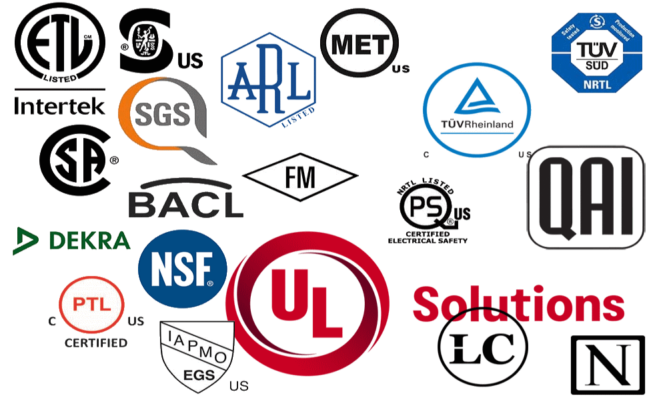UL Certification is a Band-Aid®

Safety certification in the US is more complicated than it should be. A big part of this is that Underwriters Laboratory (UL) plays a dual role in the ecosystem. I recently got in an extended discussion with a UL Supremacist around this, after I said something was UL Certified when that wasn’t technically true, because UL is a Band-Aid®, and I talking about flexible fabric bandages.
What I should have said initially, and later clarified, is that the device conforms to UL standard 2594. This conformity was verified by SGS, a certification agency that provides the same service as UL’s testing/certification arm, and is functionally equivalent to “UL Listed”. My bad :D.
We’re in this weird situation because in the US, UL is one of the organizations that writes (and sells access to) safety standards. It also does the testing for those standards. There are other companies in the testing and certification game as well, but they don’t create the standards, and don’t have the brand recognition. This process is managed by OSHA (Occupational Safety and Health Administration) as part of it’s Nationally Recognized Testing Laboratory (NRTL) program.
If that’s not complicated enough, NRTLs aren’t completely fungible. There is an element of specialization, so they are recognized by OSHA as able to provide certification for specific safety standards. Some NRTLs have a long list, and others don’t. OSHA maintains the list, by NRTL, of the standards each is qualified to test for (e.g. SGS). If you’re ever curious if the certification logo is valid you can start at the OSHA website, and then most NRTL have their own database where you can check the OEM’s homework.
So what’s all the fuss about “UL Listed”? In simplest terms, it’s mostly branding FUD (Fear, Uncertainty, and Doubt). Very similar to the “No one gets fired for buying IBM” go-to-market strategy which coined the term “FUD”. UL testing isn’t free, it’s actually very expensive, and they charge a premium for that UL logo on the back of a product. The same basic service can be had for much less from companies like CSA, SGS, Intertek, etc., but they can’t put the incredibly recognizable UL logo on the back of the thing. Which can create confusion in the market, because a lot of people don’t understand the nuance here. Until recently I was one of those people too.
Frankly, I don’t think we, as consumers, should need to know all of that. Knowing if a product has been tested and certified shouldn’t be hard. We should be able to tell that easily by looking at a known logo on a box. The problem here is that OSHA has allowed UL to create, and profit from, this complexity.
Now I am not saying that every company tests to the same level of detail. I don’t know enough about the inner workings at the firms to have an informed opinion on that. It is possible that UL is better at it than Intertek, I just don’t know, and I’m not sure it really matters that much.
It’s also important to understand that certification isn’t mandatory for all products in the US. So there are plenty of products that haven’t undergone any 3rd party testing. Some argue that it’s unnecessary, certification just slows product development, and raises cost. It does do those things, but I am not one of those people. There is absolutely value in the testing and certification process.
Personally, I see the value primarily in few areas:
- A 3rd party that OSHA said is “good enough” has put eyes on it. We can reasonably expect that they will catch the egregious problems. There is room here to make the UL Supremacist argument that there are differences in thoroughness; “if X company phoned it in where it doesn’t matter, they could have phoned it in where it does”. That is possible, but I think it’s unlikely given the way tort law works in the US. It wouldn’t take many fires to get OSHA breathing down X company’s back, or a class action lawsuit brewing. NRTLs have massive incentives to cross their “t”s, and dot the “i”s for the stuff that matters.
- The main benefit is being in a defensible place with my insurance company should something bad happen. There is no expectation that consumers certify the devices themselves, or check the homework of the NRTL. We can reasonably trust OSHA and the NRTL to do the thing they are paid to do.
- In some locations devices need to have NRTL certification to be installed legally. Not relevant in all situations, but in general it’s also be good to be code compliant.
Which means that most of the value of safety certification (like all certifications) is signalling. It indicates an acceptable baseline of safety, and the legal certainty that your actions are defensible if it comes to that.
Obviously, there is room for a diversity of opinion around the value of brand. If having a UL sticker on the back of something makes someone sleep better, there’s individual value in that. But on the other hand, I personally am fine with paying less for a product that has an alternate NRTL logo on the back.

Thanks for the very informative article.